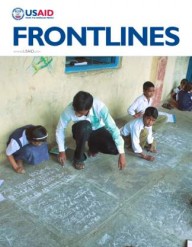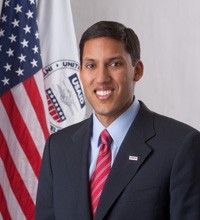In the early 1960s, James Walden worked on a USAID project that created the first ever architecture school in Bangladesh.
In 2009, a team from that school—now one of the most prominent in South Asia—won an international design competition for a pediatric clinic that could be adapted throughout East Africa: a sustainable design using local materials and labor in one of the most perilous regions in the world for mothers and their children.
For the past half-century, similar U.S. investments—in infrastructure, education, food security, health and economic growth—have been delivering results across the world. Sometimes those results are immediate. Sometimes they take longer to transform societies.
But one thing was certain about development 50 years ago: You needed to be a big international donor to make that type of investment.
That’s not the case anymore.
Now we live in a world—call it the Kiva-world—where a student anywhere can go online and choose the individual dairy farmer she wants to support in Kenya and offer that farmer a $25 loan.
That dairy farmer can then invest in her business, vaccinate her animals, improve her feedstock, and track milk output and local prices through her mobile phone using an application called iCOW. She can use that data to negotiate across different buyers and even use her phone to report suspected corruption within her local dairy cooperative.
Under this new model—I call it “open source” development—inventors around the world are able to observe that our dairy farmer’s biggest challenge is getting the milk to a chilling facility before it spoils, and can invent new forms of “on-farm” ultra-pasteurization that could solve that problem for her and others.
If we’re going to deliver on ambitious development goals within the next two decades, then we have to employ a much bigger definition of development to get us there.
Development is too important and creativity too diffuse to be left entirely to the post-World War II development institutions, including USAID.
To support an open source development approach, our Agency must serve as a platform that connects the world’s biggest development challenges to development problem solvers all around the world. We recognize that talent is everywhere, but opportunity is not.
At USAID, we are putting this idea to the test.
We’ve launched a series of Grand Challenges that have encouraged more than 1,500 innovators—nearly half from developing countries—to submit groundbreaking proposals for new technologies and approaches to save lives at birth, get all children reading, and power agriculture through clean, off-grid energy. Even when potential inventors do not win grant awards, they are able to join global communities of practice and improve their capacity to realize their mission.
We’ve launched a Development Innovation Venture fund so we can help entrepreneurs take a creative idea—like creating sustainable toilets that produce energy as a byproduct—and evaluate and scale them.
We’ve opened up our data to development-savvy tech-heads around the planet to find sustainable solutions to core problems in food security.
And in November, we launched a Higher Education Solutions Network, modeled in part on the Blum Center at Berkeley, to expand the pool of informed problem solvers in our own country and provide them the space to tackle the development challenges of our time.
But an open source development model is not just about bringing more Americans to the task. By getting into the business of sharing risk with local banks and investors using credit guarantees, we’ve unlocked more than $2.3 billion in private investment through our Development Credit Authority—helping to put local wealth to work for development. For every $1 we spend to assist businesses on the rise, those businesses are able to attract $28 in investments.
In an open source development model, we will not always have the control we have grown accustomed to exercising, and we have to get used to that.
Take, for example, Gigi Ibrahim, one of the powerful, young citizen journalists who wielded her Blackberry as a weapon of revolution in the rise against former Egyptian President Hosni Mubarak. She tweeted locations of protests, security alerts and notes to human rights organizations about the latest arrests or violations.
Several months later, Jon Stewart invited her to be a guest on The Daily Show. When asked how she came to play a pivotal part in this movement, Ibrahim explained to the rather surprised audience that she had taken a class at the American University in Cairo called the "Social Mobilization Under Authoritarian Regimes" and concentrated on the role of social media as an enabler.
I doubt that was an expected outcome when USAID funded the university for over 20 years, proving that when we start enabling networks of activity, we simply cannot know what they will end up achieving.










Comment
Make a general inquiry or suggest an improvement.